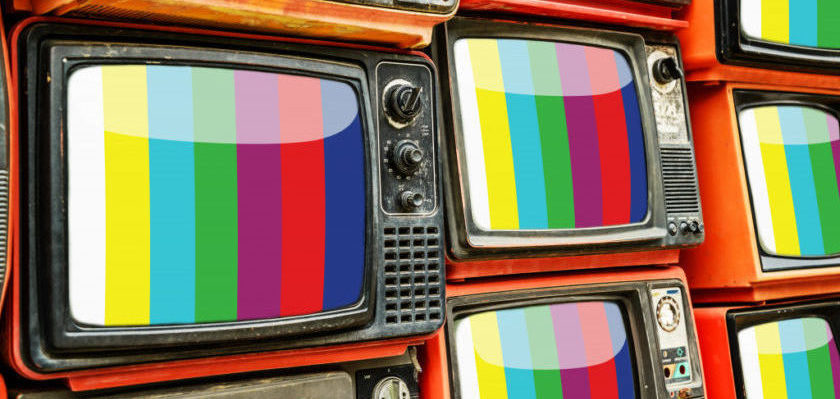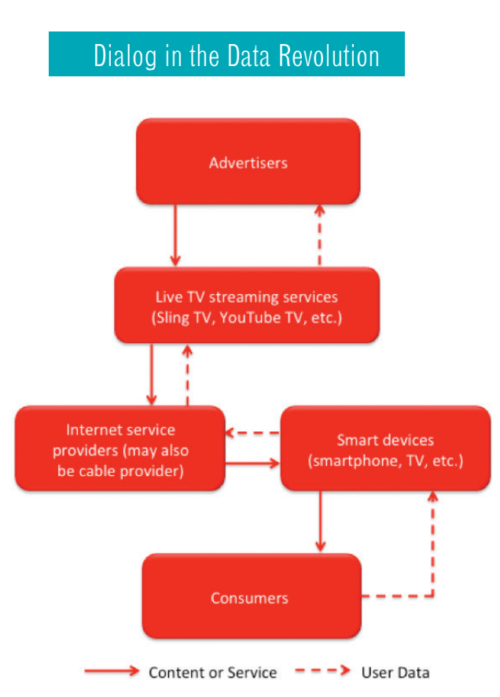Connections

M&E Journal: How New Live TV Streamers Could Transform TV With User Data
Story Highlights
By Steven Herrera, Consultant, Zaszou –
Cord cutting — switching from cable or satellite TV to online video — appeals to consumers tired of paying high prices for large bundles of channels they never watch. SVOD services such as Netflix and Amazon Prime Video offer an incredible variety of content at a fraction of the price of cable but require the viewer to make a choice around what to watch and when to watch it.
In contrast, linear television allows consumers to enjoy entertainment in “lean back” mode, leaving the programming decisions to someone else. On top of that, some content — especially live sports — cannot be widely found outside of a cable or satellite subscription. For these reasons, some consumers have been reluctant to cut the cord.
Live TV streaming services emerged to target hesitant “cord cutters,” as well as “cord nevers.” At the beginning of 2015, Dish introduced Sling TV, an internet-delivered “skinny” bundle of 20 live cable channels for $20 a month. Sony quickly followed with PlayStation Vue, and AT&T debuted DirecTV Now at the end of 2016. Last year, Google launched YouTube TV, and Hulu introduced Live TV to its service. Unlike the rest, YouTube and Hulu have many years of video streaming experience and can leverage user data to upgrade the user experience.
They will have a significant competitive advantage in this next evolution of television.
Consumers enjoy distinct benefits over cable
Depending on how a cable provider packages internet and cable TV service together, switching to one of these streaming bundles may not save consumers any money. However, live TV streaming services have no long-term contracts, and offer other advantages to consumers:
* No dedicated hardware: There is no need for a cable box or satellite dish/receiver, which also means no equipment leasing fees.
* Accessibility across devices: Streaming bundles can be accessed on mobile devices, computers, and televisions. Some services even allow for multiple simultaneous streams on the same account, so family members can watch their favorite programs separately.
* Enhanced time shifting: Most streaming bundles include cloud DVR functionality. Consumers can record programs and watch them later, but with much greater storage capacity than a physical DVR.
Right now, all these live TV streaming services are available exclusively in the U.S. There is variation in channel lineups, on-demand content offerings, and user interface quality.
 YouTube and Hulu build on their strengths
YouTube and Hulu build on their strengths
Unlike their live TV competitors, YouTube and Hulu have built-in audiences—an installed base of users who already have apps for these services on all their devices.
When a YouTube or Hulu user signs up for live TV service, the platform can immediately start making content recommendations based on that user’s entire viewing history on the platform.
Live TV streaming services leverage data from user profiles and viewing habits to create more advanced interfaces. Viewers are presented with options relevant to their interests across linear feeds, recent cloud DVR recordings and on-demand programs.
The concept is to spotlight specific programs, rather than sort content by channel. A subscription to YouTube TV includes YouTube Red Originals, while Hulu with Live TV grants access to all Hulu on-demand content, including originals.
Collecting user data from a variety of sources
To recommend programs, live TV streaming services use algorithms that track consumers’ viewing habits on their platforms. Other data collection methods can be employed:
* Smart TVs all have some form of automatic content recognition. They can pay attention to all the content the viewer is watching and determine whether the source is a broadcast feed or a DVD.
* In-home digital assistants such as Amazon Alexa are sophisticated listening devices, which can capture family members’ conversations, such as those about their favorite primetime comedies.
* Smartphones can monitor TV viewing by tapping into the microphone. Facial recognition could even determine the extent to which a TV program makes a viewer happy or sad.
The data from all these sources could be fed into live TV streaming services for more advanced content recommendations, although consumers’ informed consent is an issue.
Advertisers benefit from the data revolution
Right now, viewers watching live internet TV see the same ads that appear on conventional TV. This will soon change as live TV streaming services share user data with advertisers to deliver targeted ads.
Google could aggregate all the personal data it has already gathered on its users— across search, Gmail, Maps, and Android — and use it to micro-target ads to a specific YouTube TV viewer. Also, marketers can address several similar viewers at once — or macro-target — to create shared media moments for specific groups of consumers.
Cable providers counter with their own streaming bundles
In many cases, an internet service provider is also a provider of conventional cable TV service. As consumers move toward online video, big communications companies recognize that their broadband internet divisions are the only area of future growth. Therefore, these firms are looking for ways to entice people to their internet service. For example, Spectrum recently introduced “TV Choice” exclusively for its internet customers. Another strategy to offset the lost cable revenue is to simply charge more for internet access.
Cable’s key strength has long been regional sports networks (RSNs). If cable companies can obtain exclusive rights to stream sporting events, then they may have a competitive advantage.
The transformation of television continues
Some customers consider SVOD services to be a satisfactory replacement for cable. Others enjoy the experience of watching linear TV in “lean back” mode and want to see the content that is only available on broadcast and cable networks. For those customers, live TV streaming services are an attractive option because they offer greater flexibility and accessibility than cable. The number of online TV services is increasing, but not all are created equal.
Television is now a combination of live feeds, cloud DVR and on-demand viewing options. Google is the first big technology company to incorporate live TV, but Apple is not far behind. To succeed in the long run, it is important for live TV streaming services to invest in original content and value-added features. For consumers, the dream is to subscribe to individual channels — or better yet, individual series — on an a la carte basis. This may be technically feasible, but still has intellectual property management-related issues to be resolved. Meanwhile, these internet-delivered skinny bundles are a step in the right direction.
—-
Click here to translate this article
Click here to download the complete .PDF version of this article
Click here to download the entire Spring/Summer 2018 M&E Journal









